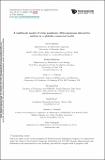Files in this item
A multiscale model of virus pandemic : heterogeneous interactive entities in a globally connected world
Item metadata
| dc.contributor.author | Bellomo, Nicola | |
| dc.contributor.author | Bingham, Richard | |
| dc.contributor.author | Chaplain, Mark A. J. | |
| dc.contributor.author | Dosi, Giovanni | |
| dc.contributor.author | Forni, Guido | |
| dc.contributor.author | Knopoff, Damian A. | |
| dc.contributor.author | Lowengrub, John | |
| dc.contributor.author | Twarock, Reidun | |
| dc.contributor.author | Virgillito, Maria Enrica | |
| dc.date.accessioned | 2020-11-13T16:30:06Z | |
| dc.date.available | 2020-11-13T16:30:06Z | |
| dc.date.issued | 2020-08-19 | |
| dc.identifier | 271218410 | |
| dc.identifier | 15165bf9-a69c-45e8-a4e4-25ace11d232b | |
| dc.identifier | 85090991017 | |
| dc.identifier | 000569327900005 | |
| dc.identifier.citation | Bellomo , N , Bingham , R , Chaplain , M A J , Dosi , G , Forni , G , Knopoff , D A , Lowengrub , J , Twarock , R & Virgillito , M E 2020 , ' A multiscale model of virus pandemic : heterogeneous interactive entities in a globally connected world ' , Mathematical Models and Methods in Applied Sciences , vol. 30 , no. 08 , pp. 1591-1651 . https://doi.org/10.1142/s0218202520500323 | en |
| dc.identifier.issn | 0218-2025 | |
| dc.identifier.other | Jisc: b1d556a797954ca7a6c06601803329bd | |
| dc.identifier.other | ORCID: /0000-0001-5727-2160/work/83481899 | |
| dc.identifier.uri | https://hdl.handle.net/10023/20974 | |
| dc.description | Funding: Mark Chaplain acknowledges the assistance of the Rapid Assistance in Modelling the Pandemic Project coordinated by the Royal Society. | en |
| dc.description.abstract | This paper is devoted to the multidisciplinary modelling of a pandemic initiated by an aggressive virus, specifically the so-called SARS–CoV–2 Severe Acute Respiratory Syndrome, corona virus n.2. The study is developed within a multiscale framework accounting for the interaction of different spatial scales, from the small scale of the virus itself and cells, to the large scale of individuals and further up to the collective behaviour of populations. An interdisciplinary vision is developed thanks to the contributions of epidemiologists, immunologists and economists as well as those of mathematical modellers. The first part of the contents is devoted to understanding the complex features of the system and to the design of a modelling rationale. The modelling approach is treated in the second part of the paper by showing both how the virus propagates into infected individuals, successfully and not successfully recovered, and also the spatial patterns, which are subsequently studied by kinetic and lattice models. The third part reports the contribution of research in the fields of virology, epidemiology, immune competition, and economy focussed also on social behaviours. Finally, a critical analysis is proposed looking ahead to research perspectives. | |
| dc.format.extent | 61 | |
| dc.format.extent | 2769276 | |
| dc.language.iso | eng | |
| dc.relation.ispartof | Mathematical Models and Methods in Applied Sciences | en |
| dc.subject | COVID-19 | en |
| dc.subject | Living systems | en |
| dc.subject | Immune competition | en |
| dc.subject | Complexity | en |
| dc.subject | Multiscale problems | en |
| dc.subject | Spatial patterns | en |
| dc.subject | Networks | en |
| dc.subject | Intracellular infection dynamics | en |
| dc.subject | Viral quasispecies | en |
| dc.subject | Virus structure modelling | en |
| dc.subject | SARS-CoV-2 | en |
| dc.subject | QA Mathematics | en |
| dc.subject | QH301 Biology | en |
| dc.subject | QR355 Virology | en |
| dc.subject | T-NDAS | en |
| dc.subject.lcc | QA | en |
| dc.subject.lcc | QH301 | en |
| dc.subject.lcc | QR355 | en |
| dc.title | A multiscale model of virus pandemic : heterogeneous interactive entities in a globally connected world | en |
| dc.type | Journal article | en |
| dc.contributor.institution | University of St Andrews. Statistics | en |
| dc.contributor.institution | University of St Andrews. School of Mathematics and Statistics | en |
| dc.contributor.institution | University of St Andrews. Applied Mathematics | en |
| dc.identifier.doi | https://doi.org/10.1142/s0218202520500323 | |
| dc.description.status | Peer reviewed | en |
This item appears in the following Collection(s)
Items in the St Andrews Research Repository are protected by copyright, with all rights reserved, unless otherwise indicated.

